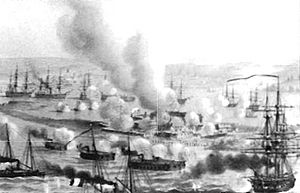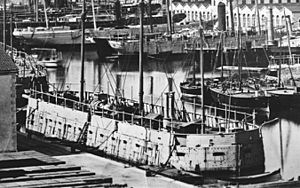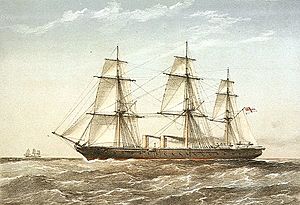Battle of Kinburn (1855) facts for kids
Quick facts for kids Battle of Kinburn |
|||||||
|---|---|---|---|---|---|---|---|
| Part of the Crimean War | |||||||
 Illustration of the ironclad batteries bombarding Kinburn |
|||||||
|
|||||||
| Belligerents | |||||||
| Commanders and leaders | |||||||
| Strength | |||||||
| 10 ships of the line 3 ironclad batteries 8,000 soldiers |
1,500 soldiers 80 guns |
||||||
| Casualties and losses | |||||||
| 2 killed 25 wounded |
c. 400 | ||||||
The Battle of Kinburn was a big fight involving both land and naval forces. It happened near the end of the Crimean War on October 17, 1855. The battle took place at the very tip of the Kinburn Peninsula in what is now Ukraine.
During this battle, a combined fleet of ships from the French Navy and the British Royal Navy attacked Russian forts on the coast. French and British soldiers had already surrounded these forts on land. Three special French ships, called ironclad batteries, led the main attack. These ships were very strong and helped destroy the main Russian fort in about three hours.
Even though this battle didn't change the overall outcome of the war much, it was very important. It was the first time modern ironclad warships were used in a real battle. The French ironclad ships were hit many times, but they easily destroyed the Russian forts. They also had very few casualties. This battle showed navies around the world that they needed to build new warships with armour plating. This started a big competition between France and Britain to build the best armored ships.
Contents
Why Kinburn Was Attacked
In September 1854, French and British armies landed on the Crimean Peninsula. They then fought their way to Sevastopol, a major Russian naval base. They surrounded the city for a long time. In September 1855, the Russian soldiers finally left Sevastopol. This freed up the French and British fleets for other missions.
The commanders discussed what to attack next. They thought about bigger campaigns, but decided on a smaller plan. They chose to capture the Russian fort at Kinburn. This fort was important because it guarded the entrance to the Dnieper River. Some British leaders thought taking Kinburn alone wouldn't do much. They felt it would just warn the Russians without a bigger plan to attack Nikolaev.
The Forces Ready for Battle
The Kinburn fort was on the Kinburn Spit, a narrow piece of land. It had three separate forts. The main fort was made of stone and had 50 guns. Some of these guns were protected inside strong rooms called casemates. Others fired over the walls. Two smaller forts were further down the spit. They had ten and eleven guns each. The forts only had medium-sized guns, with the largest being 24-pounders.
About 1,500 Russian soldiers defended the forts. Their commander was Major General Maxim Kokhanovitch. Across the water, at Ochakov, was Fort Nikolaev with fifteen more guns. But these guns were too far away to help in the battle.
The British and French gathered a large fleet to attack Kinburn. It included four French and six British large warships called ships of the line. These were led by British Rear Admiral Edmund Lyons and French Vice Admiral Armand Joseph Bruat. The British also had seventeen smaller ships, ten gunboats, and six bomb vessels. The French had three corvettes, four avisos, twelve gunboats, and five bomb vessels.
Transport ships carried 8,000 soldiers from the French and British armies. These soldiers would surround the forts on land.
New Ironclad Warships
The French fleet also brought three brand new, experimental ironclad warships. These were the first three ironclad batteries ever built: Lave, Dévastation, and Tonnante. They had arrived too late to help at Sevastopol. These ships were special because they had eighteen 50-pounder guns. They were also protected by 4 inches of strong wrought iron armor. Many people thought these new ships would not be very good in battle. They were slow and hard to steer.
The Battle Begins
To trick the Russians, the combined fleet first sailed west toward Odessa on October 8. Then, they turned east and headed for Kinburn. The fleet arrived off Kinburn on October 14. That night, nine gunboats helped transport 8,000 soldiers to land behind the forts. The soldiers, led by François Achille Bazaine, started digging trenches. The gunboats fired at the main fort, but not very effectively at first.
By the morning of October 17, the soldiers had dug good trench positions. French troops faced the forts, and British troops guarded against any Russian counterattack. The French even started digging closer to the fort. Bad weather had kept the main fleet from attacking earlier.
Around 9:00 AM on October 17, the Anglo-French fleet moved into position. The large ships had trouble getting close because the water was shallow. So, the smaller ships, especially the three ironclad batteries, did most of the work.
The ironclad batteries anchored only 600 yards from the Russian fort. They were amazing! Russian cannonballs just bounced off their strong iron armor. The French and British large ships stayed further out, about 1,200 yards away. The bomb vessels were even further, at 2,800 yards. As the ironclads fired, their Royal Marines also shot at the Russian gun crews. Only one shell hit the Dévastation through a gun opening. It killed two men but didn't seriously damage the ship.
The constant firing started fires in the main fort. It quickly broke many of the Russian guns. Once the Russian firing slowed down, the gunboats moved in closer. They also started firing at the forts. By noon, the main fort was completely destroyed by the combined power of the Anglo-French fleet.
A Russian soldier raised a white flag to show they surrendered. General Kokhanovitch then came out to talk to the French commander. About 1,100 of the 1,500 Russian soldiers survived. They were allowed to leave without their weapons. Only two French and British soldiers were killed, and 25 were wounded. All the wounded were on the ironclad batteries. The Dévastation was hit 75 times, Lave 66 times, and Tonnante about the same. None of the ships had more than small dents in their armor.
What Happened Next
On October 20, the French soldiers explored the area toward Kherson. They didn't find any Russian resistance. After returning to Kinburn, the commanders decided to keep the fort and rebuild it for the winter. About 1,700 soldiers and the three ironclad batteries stayed behind. The rest of the forces went back to Crimea.
The British had thought about going further up the Dnieper River to capture Nikolaev. But after taking Kinburn, they realized they would need many more soldiers. The war ended before they could try to take Nikolaev in 1856.
Taking Kinburn didn't have a huge impact on the war's outcome. However, it showed that the French and British navies were very good at landing troops and attacking from the sea. They also had new technology that gave them a big advantage over the Russians. The destruction of Kinburn's forts meant the Russians had no strong naval forces left in the Black Sea.
Austria, which was still neutral, put pressure on Czar Alexander II of Russia. This led the Czar to ask for peace. The war officially ended in February 1856 with the Treaty of Paris.
French Admiral Bruat told his leaders that "Everything may be expected from these formidable engines of war." The success of the ironclad batteries at Kinburn convinced French Emperor Napoleon III to order more ironclad warships. Their success, along with how powerful new shell-firing guns were against wooden ships at the Battle of Sinop, made most French naval officers support these new armored ships.
Napoleon III's plan led to the first true sea-going ironclad, Gloire. This started a naval building race between France and Britain. It lasted until the Franco-Prussian War began in 1870. The British Royal Navy already had five ironclad batteries being built. After the victory at Kinburn, they ordered four more. To answer Gloire, they built their own armored frigates, Warrior and Black Prince. France built eleven more batteries, and the Russian Navy built fifteen armored rafts to defend their harbors.
See also
- Battle of Kinburn (1787)




